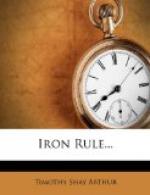Amid all the perverseness that marked the character of Andrew; amid all his hardness and wrong-doing; his attachment to Emily Winters remained as pure and earnest at sixteen, as when a child he suffered punishment rather than give up her society. Emily, who was about his own age, had grown, by this time, into a tall, graceful girl, and was verging on toward womanhood with a rapidity that made the boy’s heart tremble as he marked the distance which an earlier development of body was placing between him and the only one, except his mother, that he had ever loved.
Between the families of Mr. Howland and Mr. Winters there was no intercourse. Mr. Howland early imbibed a strong prejudice against Mr. Winters, who did not happen to be a church member, and who, on that account, was believed by Mr. Howland to be capable of doing almost any wrong action, if tempted thereto. Certain things done by Mr. Winters, who was independent in his modes of thinking and acting, had been misunderstood by Mr. Howland, or judged by one of his peculiar standards of virtue. From that time he was considered a bad man; and, although Mrs. Winters, who was a woman beloved by all that knew her, called upon Mrs. Howland when the family of the latter came into the neighborhood, Mr. Howland positively forbade a return of the call. Less obedient to his arbitrary commands did he find his son. Andrew formed an early friendship for little Emily, and sought every opportunity, spite of restriction and punishment, to enjoy her society.
This was continued until the children grew to a size that caused the parents of Emily to observe the attachment as one far from being agreeable to them, and to feel (sic) desirons of drawing a line of separation between their daughter and a boy so notoriously bad as Andrew Howland. When the children were twelve years old, they felt bound to take some action in the case, and began by giving Andrew a gentle hint, one day, to the effect that his visits to their house were rather too frequent. This was enough for the high-spirited boy. He left, with a burning spot on his cheek, vowing, in his indignation, that he would never enter their door again, nor speak to Emily. But it was much easier to keep the first part of this promise than the last. As early as the next day he met Emily on his way to school. She was going to school also, and had much farther to, walk than himself. To enjoy her society, he went with her all the way. This made him late, and he was in consequence, kept in by the teacher, half an hour after his own school was dismissed. But this punishment did not deter him from repeating the act on the next day and on the next. From that time he rarely came to school until ten or fifteen minutes after the session was opened; and, sometimes, Emily was late also. Reproof and punishment doing no good, the teacher sent a note to Andrew’s father, complaining of his want of punctuality. A severe reprimand was the consequence. This failing of the desired effect, the boy was put on bread and water for days at a time. But complaints from the teacher still arriving, corporeal punishment was added. No change, however, followed. In the end Andrew was sent home from school as incorrigible.




